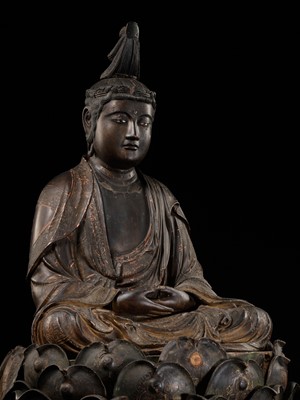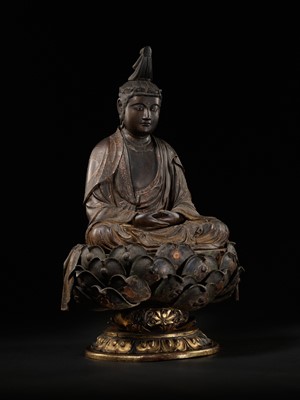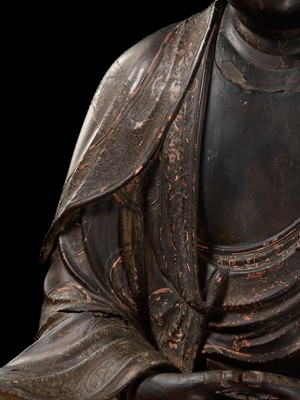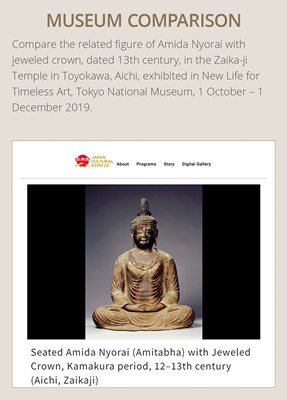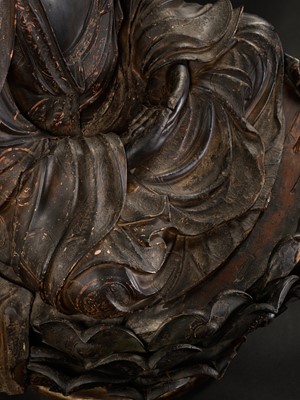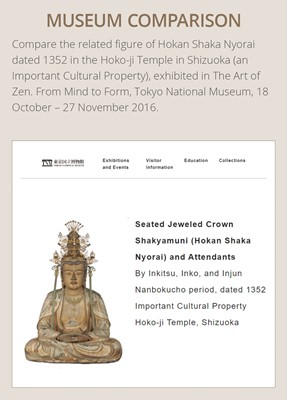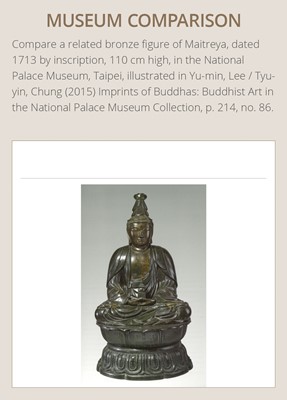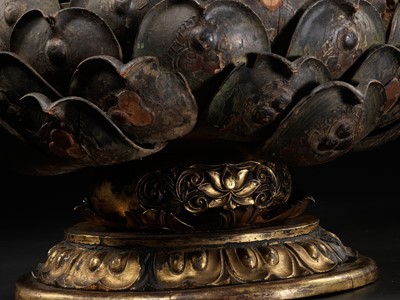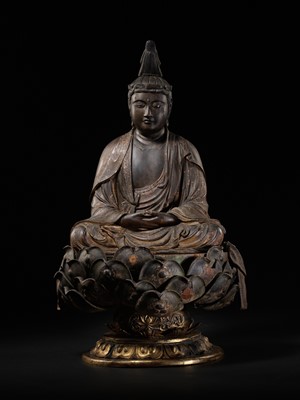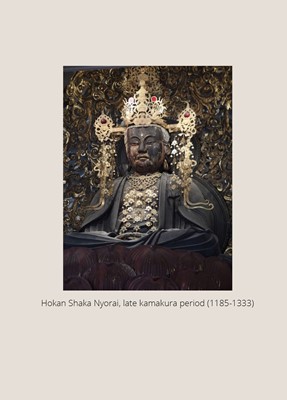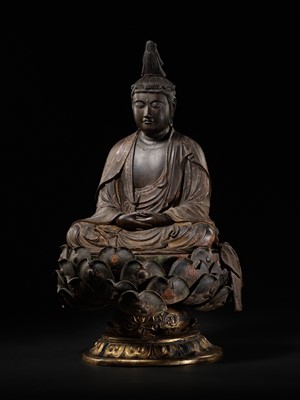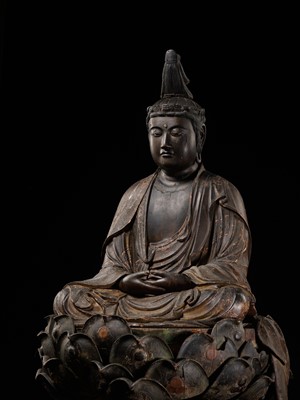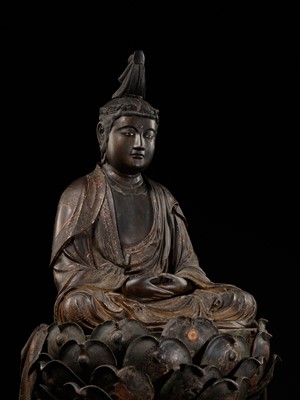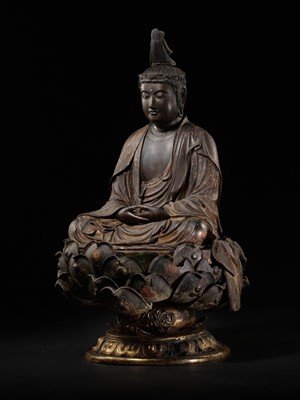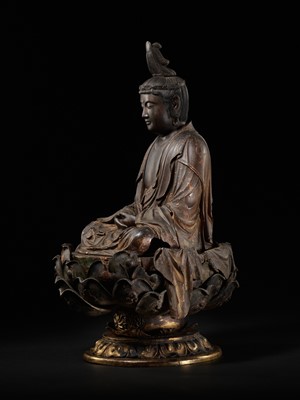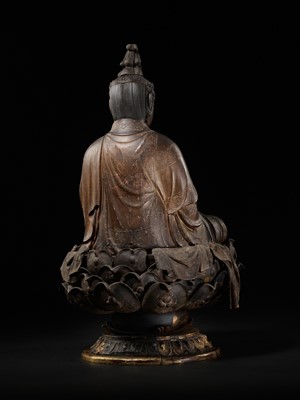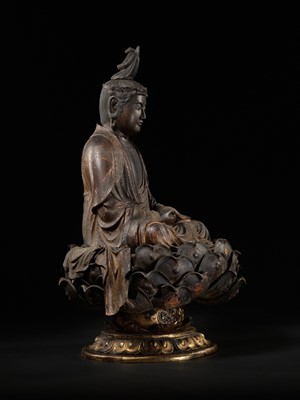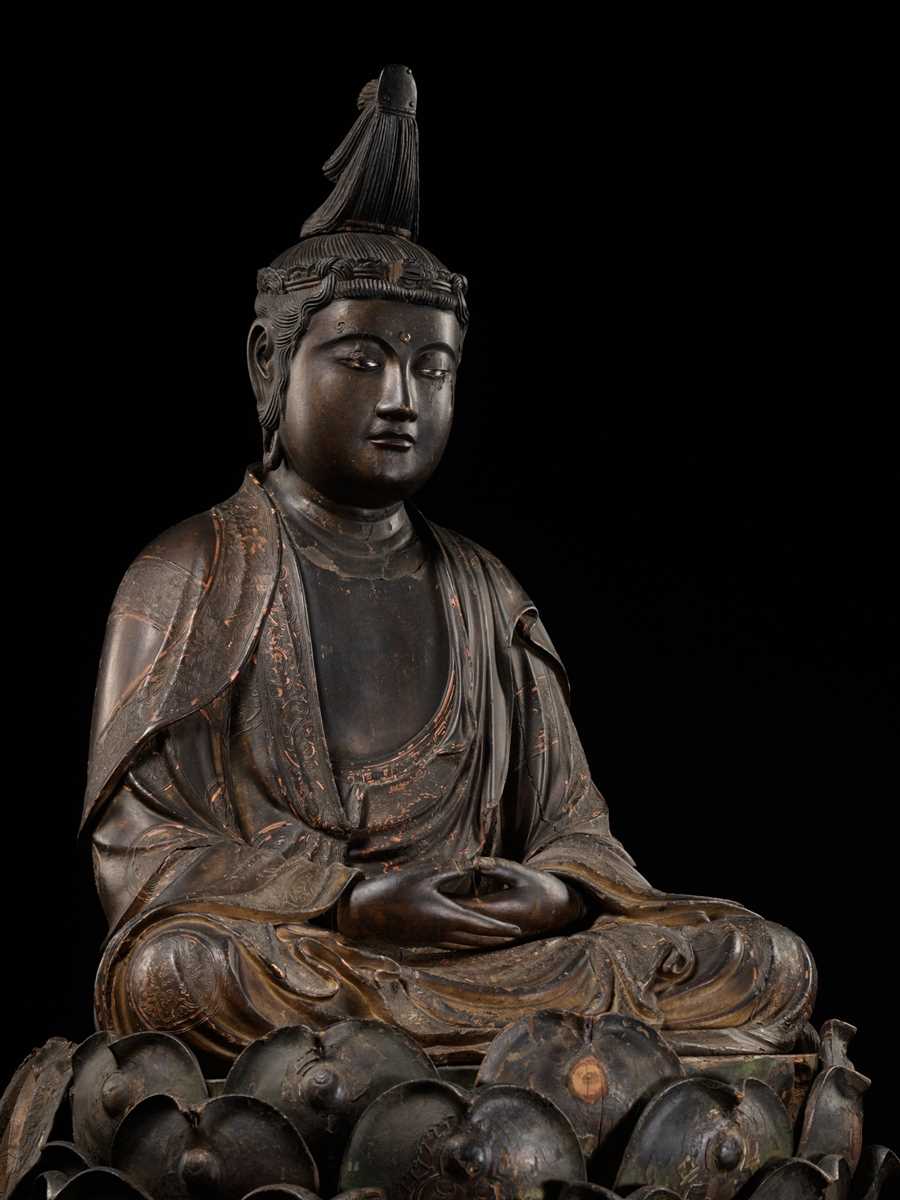16th Jun, 2023 11:00
Fine Japanese Art
44
A VERY LARGE AND RARE LACQUERED WOOD FIGURE OF HOKAN SHAKA NYORAI, MUROMACHI PERIOD
Sold for €46,800
including Buyer's Premium
Japan, 14th-16th century, Muromachi period (1333-1573)
Finely carved and assembled in yosegi-zukuri technique, painted in gofun, polychrome pigments, lacquer and gold leaf. The robe is decorated in relief with flowers and scrolls in a technique called domon 土紋, a decoration made from clay and fixed with lacquer. The hairstyle is topped with a high bun called hokei and girded with a thin tiara, the tenkandai. Two holes in the tenkaidai show that originally a golden copper crown, hokan, was attached to the head. Hokan Shaka Nyorai (the historical crowned Buddha) is shown seated in dhyanasana atop a tall lotus throne with individually carved petals, the hands lowered in zenjo-in (dhyana mudra). The serene face with heavy-lidded eyes below gently arched brows centered by a rock crystal byakugo (urna).
The base consists of three tiers: - a round gilded base decorated with stylized upside-down lotus petals; - above it, a thin open lotus flower on which rests a carved and open-worked element decorated with lotus flowers and scrolls; - then, a large lotiform base whose petals are realistically carved. Each of the petals is covered with an ornament painted in polychrome and in relief according to the domon technique representing the three sacred jewels on a lotus (Sanbo no shinboru - 三宝のシンボル) symbolizing the Buddha: the enlightened one who has attained Nirvana, the Dharma: the Buddha's teaching, and the Shanga: the Buddhist monastic order.
HEIGHT 74 cm (the figure) and 112 cm (total)
Condition: Good condition, commensurate with age. Extensive wear, age cracks, chips, losses, flaking, repairs and touchups, nicks, scratches. The mandorla and crown are lost.
Provenance: From a private collection in Paris, France.
Museum comparison:
Compare the related figure of Amida Nyorai with jeweled crown, dated 13th century, in the Zaika-ji Temple in Toyokawa, Aichi, exhibited in New Life for Timeless Art, Tokyo National Museum, 1 October – 1 December 2019. Compare the related figure of Hokan Shaka Nyorai dated 1352 in the Hoko-ji Temple in Shizuoka (an Important Cultural Property), exhibited in The Art of Zen. From Mind to Form, Tokyo National Museum, 18 October – 27 November 2016. Also compare a related bronze figure of Maitreya, dated 1713 by inscription, 110 cm high, in the National Palace Museum, Taipei, illustrated in Yu-min, Lee / Tyu-yin, Chung (2015) Imprints of Buddhas: Buddhist Art in the National Palace Museum Collection, p. 214, no. 86.
Japan, 14th-16th century, Muromachi period (1333-1573)
Finely carved and assembled in yosegi-zukuri technique, painted in gofun, polychrome pigments, lacquer and gold leaf. The robe is decorated in relief with flowers and scrolls in a technique called domon 土紋, a decoration made from clay and fixed with lacquer. The hairstyle is topped with a high bun called hokei and girded with a thin tiara, the tenkandai. Two holes in the tenkaidai show that originally a golden copper crown, hokan, was attached to the head. Hokan Shaka Nyorai (the historical crowned Buddha) is shown seated in dhyanasana atop a tall lotus throne with individually carved petals, the hands lowered in zenjo-in (dhyana mudra). The serene face with heavy-lidded eyes below gently arched brows centered by a rock crystal byakugo (urna).
The base consists of three tiers: - a round gilded base decorated with stylized upside-down lotus petals; - above it, a thin open lotus flower on which rests a carved and open-worked element decorated with lotus flowers and scrolls; - then, a large lotiform base whose petals are realistically carved. Each of the petals is covered with an ornament painted in polychrome and in relief according to the domon technique representing the three sacred jewels on a lotus (Sanbo no shinboru - 三宝のシンボル) symbolizing the Buddha: the enlightened one who has attained Nirvana, the Dharma: the Buddha's teaching, and the Shanga: the Buddhist monastic order.
HEIGHT 74 cm (the figure) and 112 cm (total)
Condition: Good condition, commensurate with age. Extensive wear, age cracks, chips, losses, flaking, repairs and touchups, nicks, scratches. The mandorla and crown are lost.
Provenance: From a private collection in Paris, France.
Museum comparison:
Compare the related figure of Amida Nyorai with jeweled crown, dated 13th century, in the Zaika-ji Temple in Toyokawa, Aichi, exhibited in New Life for Timeless Art, Tokyo National Museum, 1 October – 1 December 2019. Compare the related figure of Hokan Shaka Nyorai dated 1352 in the Hoko-ji Temple in Shizuoka (an Important Cultural Property), exhibited in The Art of Zen. From Mind to Form, Tokyo National Museum, 18 October – 27 November 2016. Also compare a related bronze figure of Maitreya, dated 1713 by inscription, 110 cm high, in the National Palace Museum, Taipei, illustrated in Yu-min, Lee / Tyu-yin, Chung (2015) Imprints of Buddhas: Buddhist Art in the National Palace Museum Collection, p. 214, no. 86.
Zacke Live Online Bidding
Our online bidding platform makes it easier than ever to bid in our auctions! When you bid through our website, you can take advantage of our premium buyer's terms without incurring any additional online bidding surcharges.
To bid live online, you'll need to create an online account. Once your account is created and your identity is verified, you can register to bid in an auction up to 12 hours before the auction begins.
Intended Spend and Bid Limits
When you register to bid in an online auction, you will need to share your intended maximum spending budget for the auction. We will then review your intended spend and set a bid limit for you. Once you have pre-registered for a live online auction, you can see your intended spend and bid limit by going to 'Account Settings' and clicking on 'Live Bidding Registrations'.
Your bid limit will be the maximum amount you can bid during the auction. Your bid limit is for the hammer price and is not affected by the buyer’s premium and VAT. For example, if you have a bid limit of €1,000 and place two winning bids for €300 and €200, then you will only be able to bid €500 for the rest of the auction. If you try to place a bid that is higher than €500, you will not be able to do so.
Online Absentee and Telephone Bids
You can now leave absentee and telephone bids on our website!
Absentee Bidding
Once you've created an account and your identity is verified, you can leave your absentee bid directly on the lot page. We will contact you when your bids have been confirmed.
Telephone Bidding
Once you've created an account and your identity is verified, you can leave telephone bids online. We will contact you when your bids have been confirmed.
Classic Absentee and Telephone Bidding Form
You can still submit absentee and telephone bids by email or fax if you prefer. Simply fill out the Absentee Bidding/Telephone bidding form and return it to us by email at office@zacke.at or by fax at +43 (1) 532 04 52 20. You can download the PDF from our Upcoming Auctions page.
How-To Guides
How to Create Your Personal Zacke Account
How to Register to Bid on Zacke Live
How to Leave Absentee Bids Online
How to Leave Telephone Bids Online
中文版本的操作指南
创建新账号
注册Zacke Live在线直播竞拍(免平台费)
缺席投标和电话投标
Third-Party Bidding
We partner with best-in-class third-party partners to make it easy for you to bid online in the channel of your choice. Please note that if you bid with one of our third-party online partners, then there will be a live bidding surcharge on top of your final purchase price. You can find all of our fees here. Here's a full list of our third-party partners:
- 51 Bid Live
- EpaiLive
- ArtFoxLive
- Invaluable
- LiveAuctioneers
- the-saleroom
- lot-tissimo
- Drouot
Please note that we place different auctions on different platforms. For example, in general, we only place Chinese art auctions on 51 Bid Live.
Bidding in Person
You must register to bid in person and will be assigned a paddle at the auction. Please contact us at office@zacke.at or +43 (1) 532 04 52 for the latest local health and safety guidelines.
